INTRODUCTION
Hovhaness is among the most prolific of composers - in company with restless
creators like Milhaud, Martinu and Villa-Lobos. His catalogue runs to hundreds
of opus numbered works. Regretfully we must note that he destroyed stacks
of early works during the 1940s. One can imagine the state of his catalogue
if he had simply archived this 'juvenilia' in a University rather than burning
it.
Quantity is one thing - impressive as far as it goes - but what about the
quality of the music? This has come in for some opprobrium from critics affronted
at coming across music of the 1950s-1980s in such a frankly lyric vein. It
is, they maintain, too unvaried, static and too easy to listen to.
Certainly a Hovhaness symphony is easily enough recognisable but then so
are the Nielsen and Martinu symphonies. This does not take away from their
individual beauty, sturdy drama and slow-speaking eminence. Hovhaness has
quarried Armenian, Middle Eastern, Japanese and Malaysian music yet not once
does the music lapse into cheap post-card emotions or simplistic pictorialism.
Hovhaness is no brother to Ketelbey but has more in common (if we must find
parallels) with Percy Grainger, Vaughan Williams, Charles Griffes, John Foulds
and the group who may well have found their origin in his music, the minimalists
like Reich and Glass.
The pluralistic classical music market for ever in search of lyricism, exaltation
and the strangeness of the undiscovered realm need look no further than
Hovhaness's music for enduring reward and that precious sense of otherness.
Most of the following discs are from original analogue tapes. These first
emerged on Poseidon LPs (difficult to get hold of in the UK) and many were
issued in the UK on Unicorn (one of the most exciting labels of the 1970s
LP sunset era). Peter Christ's Crystal label has reissued most of those tapes
on CD gradually releasing the discs over a period starting shortly after
the launch of the CD.
These discs are a true thesaurus - a treasure house comparable, in years
to come, with the Britten Decca heritage, Medtner's Gramophone Society discs,
Bartók on Hungaroton, Stravinsky on Sony-CBS and Hindemith on DG.
A notable absentee is the Symphony No. 23 Ani Poseidon (POS 1015 played
by the Shoreline and Highline bands). To date this has not made it to Crystal
CD.
© Rob Barnett
ALAN
HOVHANESS (1911-)
Symphony No. 11 All Men Are Brothers (1970) 32:26 *
Armenian Rhapsody No. 1 (1944) 4:54 ** Prayer of Saint Gregory
(1946) 4:47 ** Tzaikerk (1945) 10:32 **
 * RPO/Alan
Hovhaness ** Crystal Chamber Orchestra/Ernest Gold * RPO/Alan
Hovhaness ** Crystal Chamber Orchestra/Ernest Gold
 rec * London 6
July 1970; 31 Aug/1 Sept 1975 (composer present) CRYSTAL RECORDS CD801
[53:02] rec * London 6
July 1970; 31 Aug/1 Sept 1975 (composer present) CRYSTAL RECORDS CD801
[53:02] |
 |
Save around 22% with
Crotchet
Amazon
US |
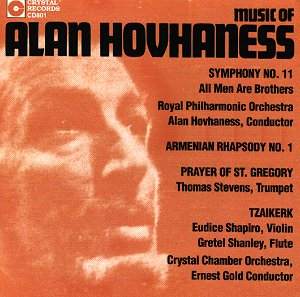
Alan Hovhaness's full name is Alan Hovhaness Chakmakjian. The 'Chakmakjian'
has been discarded, at least for artistic purposes. The name is Armenian
in origin although he was born in Somerville, Massachusetts on 8 March 1911
of Scottish and Armenian parents.
Hovhaness was way ahead of the mystic fashions of the 1960s and 1970s: hippiedom,
TM, Indian mysticism (The Beatles visiting Maharishi Mahesh Yogi). The ethnic
sound has become very popular these days so it is difficult to know why Hovhaness
has not made more progress. You need only look at the rising reputation of
Avet Terteryan (ASV and BMG Melodiya), whose regionally accented music is
so distinctive, to wonder what has happened.
Hovhaness's Symphony No. 11 is, in the composer's words: 'an attempt to
expressive a positive faith in universal cosmic love as the only possible
ultimate goal for man and nature. Let all unite on our tiny planet, our floating
village, our little space ship as we journey across mysterious endlessness.'
As an aspiration who could argue with this? As for reality, well, let that
not tarnish the vision. While much of Hovhaness's philosophical message sounds
similar to Scriabin's grand visions the music is very different.
The Symphony was premiered in New Orleans conducted by Frederick Fennell
on 21 March 1961 then completely rewritten and the new version given its
world premiere with Werner Torkanowsky (whose name I always remember for
a magical radio performance of Ned Rorem's Lions) with the New Orleans
PO on 31 March 1970.
The first movement has an initial Brahmsian string density (perhaps exacerbated
by the age of the recording?) moving into an interlude of harp passes and
bell-tolling exoticism. Then not, for the last time, we move into a Vaughan
Williamsy sound-bed of strings over which the brass cry out in austerity.
The second movement is an oriental dance with, again, strange RVW-style sounds
and Rózsa-like barbarian music. The folk dances suggested here might
easily have come from Somerset! The finale consummates in a hymn in praise
of the universe. This melody is grounded by deliciously discordant strokes
on the vibraphone. This is alternated with a string anthem with accents again
fully worthy of RVW. 'And the voice of the Lord Buddha was heard like the
sound of a great gong hung in the skies, saying that though one met a thousand
men on his way they would all be one's brothers.' We return to the harp passes
and bell tolling exoticism. The brass call across eternity and usher the
work to a dignified and impressive close.
Armenian Rhapsody No. 1 is melodic music with a coursing pulse. The flavours
of the Middle East are strong and instantly recognisable - close to Holst's
Beni Mora. The twists and turns of the writing ground you firmly in
the exotic. All three Armenian Rhapsodies are here to be experienced
across three Crystal discs. The Prayer of St Gregory (from his 1944
opera Etchmiadzin) is a quietly sinuous trumpet psalm over a bed of
strings - an Oriental extension of the Tallis Fantasia. Occasionally
I thought also of the string essays of Gerald Finzi.
Tzaikerk is the second longest essay on the disc and is flutteringly done
by Gretel Shanley (flute) with the serene, viola-toned violin of Eudice Shapiro
underpinning and partnering the constant flighty activity of the flute. Gradually
the flute calms into single held notes while the violin sings out in dignified
reflection.
The music is there to discover and enjoy. I recommend this disc.
Reviewer
Rob Barnett

ALAN HOVHANESS
(1911-) Symphony No. 9 Saint Vartan*
(1949-50) 43:51 Artik Concerto for Horn and
Strings** (1948) 17:55
 *National
PO of London/Alan Hovhaness, **Meir Rimon (horn) **Israel PO/David
Amos *National
PO of London/Alan Hovhaness, **Meir Rimon (horn) **Israel PO/David
Amos  Recorded
* London 1974; ** Mann Auditorium, Tel Aviv, 1982 CRYSTAL RECORDS CD802
[61:54] Recorded
* London 1974; ** Mann Auditorium, Tel Aviv, 1982 CRYSTAL RECORDS CD802
[61:54] |
 |
Save around 22% with
Crotchet
Amazon
US |
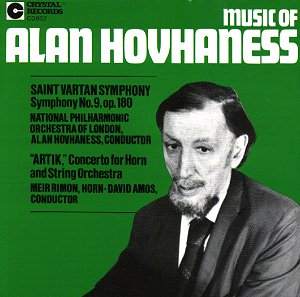
Even at the grocer's level of sheer numbers, the 27 symphonies of Miaskovsky
and the 32 of Havergal Brian are dwarfed by the 67+ symphonies of Alan Hovhaness.
The Miaskovsky and Brian symphonies on CD seems quite manageable in this
context with the completion of both cycles almost within our grasp. As a
pursuer and listener of all three cycles on disc and on broadcast tape I
still need to hear the Hovhaness symphonies 3, 10, 14, 27-28, 30, 32-35,
37, 41-42, 44-45, 49, 51-56 and 59 onwards in any form. Of the symphonies
quite a few are available on CD. Crystal is the source of most of these.
The Scottish-Armenian-US composer started his symphonic journey in 1933 with
a symphony in three movements. This was performed by the New England Conservatory
of Music but the work was destroyed by the composer in the mid-1940s. The
same fate was shared by six other symphonies, five string quartets, operas
and many piano pieces. The surviving symphony from that era is the one now
known as no. 1 The Exile Op. 17, completed in 1936, and premiered
under the baton of Leslie Heward by the BBC in 1939. No. 1 is available on
Delos.
The imposingly intriguing Saint Vartan symphony from the end of the potent
and turbulent 1940s is dedicated to the Mytilene artist, Hermon Digiovanno,
who became a spiritual guide to Hovhaness. It comprises 24 patins (or tiles)
each lasting less than five minutes; some very substantially less. This is
mosaic-like music. Sadly the individual patins are not separately tracked
on this disc. There are only two tracks in total in this recording.
The first episode inevitably reminds the listener of the Fauré
Pavane speeded up. The following processional is a canon for three
trumpets with percussion and explosive interventions from the gong. Then
come three arias for strings and solo brass instruments. They and their
counterparts in the second part speak a still small and peaceful voice amongst
the storm. The horn has a lilt and dip familiar from the film music of Miklos
Rózsa (El Cid). Then comes a Bar (dance) with thunderous
timpani and Tabor a religious processional. The succeeding canon features
tip-toe violins emulating an insect army creeping across a darkling plain.
In the next sequence the vibraphone (in a tribute perhaps to Roy Harris)
lofts the string passage on high. In the Bar the swirling violins
suggest a wind of swords and the Estampie is a vigorous dance (on
some strange village sward) and hectic buzzing insects. To relieve the orchestral
tone there follows a Lament for trombone and piano in which the composer
plays the piano. The troubled piano part reminded me of de Falla's Love
The Magician. The sequences which conclude part 1 include a double canon
for percussion, trumpet and strings, a dance featuring awesome roles (and
rolls) for timps and gong; all in an atmosphere of exotic Medieval antiquity.
Part 2's opening Yerk (a celebration of erotic love) is scored for
alto sax, timps and vibraphone. There is an Estampie and a canon for
timps, vibraphone and strings. The high dance for violins is suffused with
noble life. The concluding Estampie reeks of the Medievalism which
I (regardless of the era in which they lived) associate with Susato and
Vejvanowsky.
Vartan might be seen as one of the life-springs of minimalism (e.g. in Reich's
much undervalued Variations for orchestra). The symphony was premiered on
11 March 1951 at Carnegie Hall with the NYPSO conducted by the composer.
As a work it demands the attention of everyone who believes in the chaotically
life-enhancing variety of 20th century symphonism. Along the way
it delivers a spiritual impact reserved for very few works.
The shorter but still substantial Artik concerto is in 8 short movements
including a pizzicato of religious melody, a Ballata and Laudi
and a motet for Tallis-like strings. A pattern is apparent: alternating
in almost every one of the eight segments strings, solo horn and then strings
again. The work is largely reflective and serious but the horn part is not
beyond expressing an affable joy. Part of this work was inspired by seeing
Mt Conway, in the USA, during a bus journey.
These recordings are from analogue tapes re-recorded digitally. I heard no
hiss at my usual listening level.
The four-fold leaflet is in English only. The leaflet offer good detailed
notes and biographical info on the composer and the artists. There is a good
photo of Amos and Rimon. The two photos of Hovhaness include a superb candid
of Hovhaness conducting on the back of the notesheet. A strangely outlined
photo of the composer is used for the cover.
Reviewer
Rob Barnett

ALAN HOVHANESS
(1911-) Symphony No. 24 Majnun (1973)
 Martyn
Hill (tenor) John Wilbraham (trumpet) Sidney Sax (violin) John Alldis Choir
National PO of London/Alan Hovhaness Martyn
Hill (tenor) John Wilbraham (trumpet) Sidney Sax (violin) John Alldis Choir
National PO of London/Alan Hovhaness
 Recorded London,
1974 CRYSTAL RECORDS CD803 48:00 Recorded London,
1974 CRYSTAL RECORDS CD803 48:00 |
 |
Save around 22% with
Crotchet
Amazon
US |
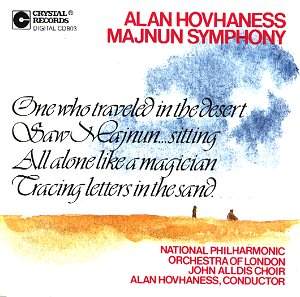
Hovhaness often seems as much an outsider as Pettersson, Havergal Brian or
Vermeulen. His exotic name has subsisted on the edges of the record catalogue
for many years. In fact 'Hovhaness' is simply the Armenian form of 'Johannes'
or 'John'.
As for his music, the received wisdom is reflected in the following quote:
"One cannot help suspecting that Hovhaness's music is too easy to write and
too easy to listen to." This was Wilfrid Mellers's verdict in 'Music in a
New Found Land' (London: 1975). This symphony gives the lie to that finding.
The story of 'Majnun and Layla' is the Persian equivalent of the 'Romeo and
Juliet' story. Hovhaness's symphony on this legend is amongst the most attractive
of his works available on disc: much more accessible than the much vaunted
Mystic Mountain symphony.
The first track segment is a canvas of string pizzicato over which solo violin
sings sweetly and none too orientally. If anything the reference points are
British pastoral with the lark ascending and swooping. At other times the
composer creates the plushest mattress of strings over which a trumpet
incantation takes us drifting from one Quiet (and desolately lonely) City
to another. Letters in the Sand sounds like quintessential Algerian
Music (do you recall the French film Le Mari du Coiffeuse) heard
accidentally as you leisurely traverse the shortwave bandwidth. At other
times a speeding pizzicato speaks of the dry and relentless desert wind.
Celestial Beloved suggests a drowsy numbness of eyes half-hooded and
of twilit rooms. Martyn Hill is in typically mournful voice but he does inject
pastel chromes into his tone. The choir are predictably on-song. Both have
a single text to sing: so short it can seem repetitive. The music often suggests
a middle-eastern Swan of Tuonela calling out across a lake of strings
but instead of a cor anglais it is a trumpet that floats in sallow mystery
across the cool waters. The Symphony can be thought of as an Armenian
Sheherazade or a modernistic Antar Symphony. It opens the door
into strange realms. In days when mystery and beauty is in short supply this
symphony deserves a much better fate than it has 'enjoyed'.
There are two criticisms of this disc. The first is that the tracking is
niggardly. There are only two tracks comprising two very substantial segments.
The sections within each segment are played without pause or tracking . The
playing time is short although the interest of the music leaves you feeling
quite satisfied.
I am now looking forward to exploring the piano music available on both Crystal
and Koch.
Reviewer
Rob Barnett

ALAN
HOVHANESS (1911-) Symphony No. 21
Etchmiadzin (1970?) [17:14] Armenian Rhapsody No. 3
(1944) [5:34] Mountains and Rivers Without End (1969?)
[24:26] Fra Angelico (1968) [16:01]
 RPO/Alan
Hovhaness RPO/Alan
Hovhaness  Recorded
London, 1971 CRYSTAL RECORDS CD804 [63:41] Recorded
London, 1971 CRYSTAL RECORDS CD804 [63:41] |
 |
Save around 22% with
Crotchet
Amazon
US |
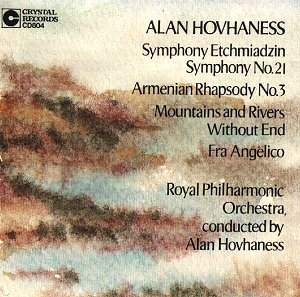
Etchmiadzin is the name of the religious capital of the Armenian church.
The Etchmiadzin Symphony is in three movements of typically lyrical
and engaging music. It is scored for bell, gong, two trumpets, timps, percussion
and strings. There is a quite striking pavane and the third movement limns
a theme which follows the outline Mount Ararat achieving a sense of static
grandeur. The finale is said to have been inspired by the priests of Etchmiadzin
who rang the city bells despite the danger of brutal invasion and inspired
their troops to victory. Unusually for Hovhaness the symphony ends with gunshots
hammering out - a vision of violence.
By contrast the Armenian Rhapsody No. 3 (1944) is for, predominantly
restful, strings. One of the tunes employed was sung to the young Alan by
his father.
Mountains and Rivers Without End is a chamber symphony in all but
name and certainly is not part of the composer's numbered canon. It is rich
with ear-entangling interest: dancing angels suggested by high singing violins
and pizzicati, slip-sliding horn, flute and cor anglais, rolling trombone
roulades, bells, the oriental ornithological serenade of the flute and high
woodwind, a maze of Messiaenic complexity, a paradisiac cloud of birdsong
and impressionistic harp and horn parts. Notable moments include at 10.20
the depths-haunted harp and flute sinking, a lively childlike tinkling dance
(14.10) and the soothing flute (14.29). All ends in pealing ecstasy. The
work was suggested by a Korean scroll painting and was surely influenced
by his time (during the 1960s) being taught by the Gagaku musician Masatoro
Togi. The music is linked to the opera The Leper King.
Fra Angelico is not for chamber ensemble. Instead it deploys the full
orchestra in his usual tenderly airy texture. Three violins in their high
harmonics takes us into celestial regions and link in with the aleatory trends
of the 1960s. A Bergian beauty hangs romantically like a light voile cloak
over the music. Swirling harps suggest oceanic depths and at 6.40 the dance
of angels. The strings chaff and coruscate while the dissolute elemental
trombones ring out chaotically.
Only the Rhapsody strikes me as at all ordinary.
Reviewer
Rob Barnett

ALAN HOVHANESS
(1911-) Requiem and
Resurrection*(1967) 15:00 * Symphony No. 19 Vishnu **
(1966) 29:20
 * North
Jersey Wind Symphony/Alan Hovhaness ** Sevan Philharmonic Orchestra/Alan
Hovhaness * North
Jersey Wind Symphony/Alan Hovhaness ** Sevan Philharmonic Orchestra/Alan
Hovhaness  CRYSTAL
RECORDS CD805 [44:20] CRYSTAL
RECORDS CD805 [44:20] |
 |
Save around 22% with
Crotchet
Amazon
US |
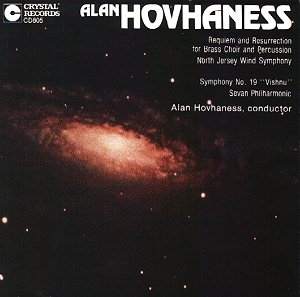
The two works on this disc are linked. The Requiem and Resurrection was
written in protest at the badly cut premiere of the Vishnu Symphony
and intending to catch the same mood and philosophy. The R&R recording
is successful hinting at Griffes Pleasure Dome a startlingly premonitory
work. There seems to have been some technical problem in that the level of
his changes noticeably after the first few seconds. Trombones snarl and brawl
their way through this oriental processional.
The Symphony presents the yielding face of the avant-garde, in its 30 minutes
traversing evocations of the distant furnace of the stars, quiet slow shrieks,
alarm bells, gongs and trombones in writhing anguish. This is not that far
removed from Ligeti. Oriental piping, drugged dreams and lumbering processionals
that might have blundered out of the Cthulhu fantasies of H.P. Lovecraft
- all are to be found in this richly decked symphony. The work is often darkly
Mahlerian but through a refractory Oriental prism. The forces of chaos move
at velocity, trombones brag and bray and the composer's trademark glissando
ululations are much in evidence. Panufnik-like antiphonal trumpet fanfares
(22.20) and oriental string dances (16.00) also cross the horizon in a work
that distinctively traverses the same territory as Robert Simpson and late
Tippett.
Rather short playing time tells somewhat against this disc which otherwise
offers some of the most challenging Hovhaness.
Reviewer
Rob Barnett

ALAN HOVHANESS
(1911-) Lady of Light * (1968) [43:15]
Avak The Healer** (1946) [21:05]
 * Patricia
Clark (soprano) * Leslie Fyson (baritone) * Ambrosian Singers * Royal
Philharmonic Orchestra/Alan Hovhaness ** Marni Nixon (soprano) ** Thomas
Stevens (trumpet) Crystal Chamber Orchestra/Ernest Gold * Patricia
Clark (soprano) * Leslie Fyson (baritone) * Ambrosian Singers * Royal
Philharmonic Orchestra/Alan Hovhaness ** Marni Nixon (soprano) ** Thomas
Stevens (trumpet) Crystal Chamber Orchestra/Ernest Gold
 Recorded London
1971 (Lady of Light); Los Angeles 1975 (Avak) CRYSTAL
RECORDS CD806 [64:24] Recorded London
1971 (Lady of Light); Los Angeles 1975 (Avak) CRYSTAL
RECORDS CD806 [64:24] |
 |
Save around 22% with
Crotchet
Amazon
US |
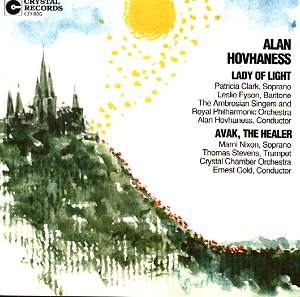
Listening to this disc I wonder how much Tavener and the mystico-religious
melodics (Rautavaara, Pärt, Silvestrov, Macmillan) owe to the Armenian
master.
Hovhaness seems never to have been a mainstream composer (despite enjoying
no shortage of commissions and being composer-in-residence with the Seattle
SO); not even during the late 1960s and early 1970s when a drug-spurred
psychedelic mysticism became woven into popular culture: San Francisco, The
Beatles, Maharishi Mahesh Yogi and Tibetan pilgrimages. From an earlier era
we also recall Cyril Scott and his mystical essays, Scriabin, Sorabji and
even Britten's Prince of the Pagodas and Gamelan Anklung.
The muscular, large-scale cantata, Lady of Light has a winning strangeness
that is bound to make it new friends if only people will give it one hearing.
The music is, like all Hovhaness, singable and Eastern all at the same time.
This is not Russian orientalism, nor French nor anyone else's but taps a
sense of authentic otherness on which few can draw.
Along the way, throughout this piece, the music seems to be floating upwards
amid bells and sinuous woodwind figures. Pat Clark is in full splendour:
articulating the softest erotic undulations. The section describing dancing
to the sun is a brother to Holst's Hymn of Jesus. Listen to the chaos
of swaying voices at 39.50. Winding and striding strings provide a backdrop
to mournful bells. Listen also to the quiet cataract of violins at 30.10.
Great pizzicati from deep in the orchestra suggest the possessed legs and
feet of the doomed dancer who possesses and intoxicates all who see her.
She is like some Pied Piper dancer in the light - a young maiden who lead
them into an ecstasy of dance; a drugged vision where the infatuates fly
through the power of dance. Finally the woman dancer is killed and the war-priest
and his army are destroyed. Leslie Fyson is pretty clear and preferable to
the rather mournful Martyn Hill in Majnun.
Avak has Hovhaness's hieratically singing trumpet floating over a bed of
Vaughan Williams-style (Tallis) strings with cross-currents evocative
of Rózsa's summer nights in Hungary. As for the purity of Marni Nixon's
voice swaying and dancing in the heat haze it deserves far more celebrity
than it has ever been accorded. This is a disc for voice aficionados as well
as those keen to hear Hovhaness tackling the human voice.
There is a good colour picture of the composer on back of the insert booklet
which also includes all the words as well as typically helpful detail.
Another triumph in the Crystal Hovhaness series.
Reviewer
Rob Barnett

ALAN
HOVHANESS (1911-) Symphony No. 25 Odysseus
(1973) [35:47] Symphony No. 6 Celestial Gate
(1959) [19:39] Prayer of Saint Gregory (from opera
Etchmiadzin) (1946) [4:22]
 Polyphonia
Orchestra/Alan Hovhaness Polyphonia
Orchestra/Alan Hovhaness
 CRYSTAL RECORDS
CD807 [60:02] CRYSTAL RECORDS
CD807 [60:02] |
 |
Save around 22% with
Crotchet
Amazon
US |
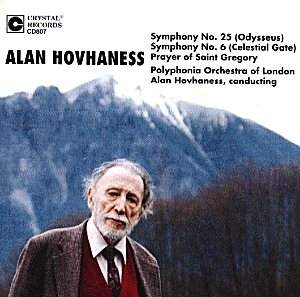
Hovhaness famously torched a stack of Sibelian compositions in the 1940s
and spent a year in India on a Fulbright scholarship. He then had a Rockefeller
grant for music research in Japan and India. A treasure chest of exotic
influences stood him in good stead a fact in evidence in these two symphonies.
The 25th Symphony is a large-scale work running to more
than 35 minutes and here tracked in two parts. The Homeric subject Odysseus
and the lanky concert overture Fra Angelico have points in common
including the trademark violins in slip-sliding ascent. Restoration sovereignty
dances in the trumpet parts at 8.00 in part I. There are ant-swarms, woodwind
soliloquies, grand courtly dances (10.40), sharply tambourine-accented dance.
Brusque string shudders and stabs (9.03 - Part II) counterpoint with drums
in some of the most dramatic (and alongside Mountains And Rivers Without
End some of the most avant-garde) music he has penned. Equilibrium returns
in the dewy and exhaustedly Baxian web-weave of the last five minutes. Recently
I heard a tape of Theodor Berger's Homerisch Sinfonie and was struck
by the similarly silken net of strings that launch the Berger work.
The world premiere of Odysseus was given by the same orchestra conducted
by the composer at the Queen Elizabeth Hall, London on 10 April 1974.
Celestial Gate is the name of a painting by Hovhaness's spiritual guide,
the artist, Hermon di Giovanno. In this work the composer has produced one
of his most approachable works in compact form running just short of 20 minutes.
The strings are a powerful presence at first in sustained adagio-like lyricism
and then in ghoul-bedevilled activity. Barber's Adagio for Strings could
easily have been a model and Basil Poledouris might well have been influenced
by this work in his Conan film scores. The score is nicely varied
and episodes tend to move very quickly from mood to mood making this (and
the Majnun symphony) a good vehicle for introducing people to Hovhaness.
It is noteworthy that in both the symphonies recorded here the orchestra
comprises single instruments from woodwind and brass with the depth of canvas
provided by multiple strings.
The Prayer of Saint Gregory meanders rhapsodically. Its cantorial trumpet
weaves in liquid tones around and over a starry bed of strings. The debt
to Tuonela is an oblique one but debt it remains; more direct is the
tribute to Vaughan Williams' Tallis.
Reviewer
Rob Barnett

ALAN HOVHANESS
(1911-) Magnificat* (1958) [29:22] Saturn**
(1971) [24:27]
 * Audrey
Nossaman (sop); Elizabeth Johnson (con); Thomas East (ten); Richard Dales
(bar); University of Louisville Choir, Louisville Orchestra/Robert Whitney.
/ ** Kate Hurney (sop); Lawrence Sobol (cl); Martin Berkovsky (piano) * Audrey
Nossaman (sop); Elizabeth Johnson (con); Thomas East (ten); Richard Dales
(bar); University of Louisville Choir, Louisville Orchestra/Robert Whitney.
/ ** Kate Hurney (sop); Lawrence Sobol (cl); Martin Berkovsky (piano)
 CRYSTAL RECORDS
CD808 [53:57] CRYSTAL RECORDS
CD808 [53:57] |
 |
Save around 22% with
Crotchet
Amazon
US |
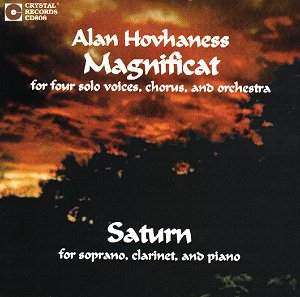
Hovhaness's spiritual teacher was the painter Hermon DiGiovanno. DiGiovanno
lead him to explore the cultures of Armenia, Greece, Egypt and India. This
coincided with his decision to incinerate his many works in 1943 and to establish
an amateur string orchestra in New York to play his and others' music. His
music of that time included the oriental aleatory or Spirit Murmur;
its slipping and sliding violins widely imitated in the early 1960s.
This disc presents one major (though comparatively short) choral/orchestral
work and one chamber work. Both have the voice as their placid focus.
The Magnificat was premiered at Wichita Falls, Texas on 26 January
1959. Its inaugural celestial fanfare is one of Hovhaness's kindest themes,
intoned delicately by trombone, trumpet and horn. Beauty too kindles all
of the choral singing which may well have inspired John Rutter (Requiem
and Gloria). Hovhaness may have taken inspiration from Howells,
Fauré, Hadley and Finzi though the final result is different from
each. The baritone is rather under-powered but the other singers rise reasonably
(and better) to the challenge. The recording quality on the
Misericordia track (7) causes a transient blast of distortion on the
sustained high notes of the soprano but nothing serious. This work is not
strongly oriental and, as the notes suggest, conveys some of what we may
take as the blessed and vital spirit of the early Christian church. All is
gentle until the rustling hornet flight of the strings at Esurientes Implevit
Bonis (9) and strangeness descends again in the cackling whispers of
Sicut Locutus est (11). The final Gloria Patri runs forward
with a Christmassy trumpet solo of sweet repose after which the choir follow
in similarly exalted style.
Saturn is in 12 miniature movements. It is a study (or I take it to
be) in the loneliness of space and its far remote dark worlds. Saturn
Celestial Globe (16) introduces some humanity (is it intended as a reference
to human life or some Apollonian alien culture?) in a dance for clarinet
entwining the soprano voice while the piano keeps up a constant filigree.
This mood continues into O Lost Note. I can imagine this music also
being sung by the composer's wife Hinako Fujihara. The sounds of perpetual
cataracts are evoked in Giant Globe and On Wings of a Soundless
Note.
As in all of this series the full texts are here together with positively
helpful notes giving background on the composer and the works.
The Magnificat was licensed from Louisville so I wonder if there is
any chance they can pick up a licence for symphony No. 15 Silver Pilgrimage
originally recorded on Louisville LP LS662 and couple it with the Poseidon
recording of the Ani symphony. If that happened it would naturally
occupy the gap left in the Crystal catalogue number sequence: CD 809. I
understand that this is unlikely as there has been talk about the Louisville
series systematically emerging on CD reissue.
As with many (all?) of these discs the original tapes are analogue. There
is supposed to be some hiss. The technicians at Crystal sagaciously resisted
the temptation to remove it, knowing full well that this usually robs the
bloom of the original. Hiss is best filtered by the mind of the listener
rather than the subtle hand of the audio-techie.
Another strong disc in the series.
Reviewer
Rob Barnett

ALAN
HOVHANESS (1911-) And God Created Great Whales
for orchestra with taped whale song (1970) [12:51] Concerto
No. 8 for Orchestra (1953) [21:56] Elibris (Dawn God of
Urardu) [10:08] Alleluia and Fugue (1942) [10:24]
Anahid - Fantasy for chamber orchestra (1944) [14:14]
 Christine
Messiter (flute) in Elibris Philharmonia Orchestra/David Amos Christine
Messiter (flute) in Elibris Philharmonia Orchestra/David Amos
 Recorded 18-19
July 1988, St Barnabas Church, Mitcham, England CRYSTAL RECORDS CD810
[69:53] Recorded 18-19
July 1988, St Barnabas Church, Mitcham, England CRYSTAL RECORDS CD810
[69:53] |
 |
Save around 22% with
Crotchet
Amazon
US |
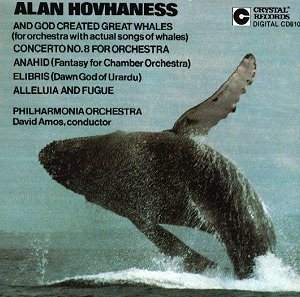
Unlike the recordings featured on many other discs in the series this one
is not composer-conducted. It also happens to have the longest playing time.
Amos is pictured in conducting action on the back cover insert. The notes
are on a three way fold.
We start with one of Hovhaness's most celebrated works: And God Created
Great Whales (1970). This mixes the taped sounds of the 'song' of various
species of whale (there is a scholarly introduction from Peter Christ indicating
the source of the various recordings and the species of whales) with a mystical
score calling up the wash and depth of an imagined Eastern sea. There are
some conceptual parallels here with the taped birdsong in Einojuhani Rautavaara's
Cantus Arcticus. This is a powerful amalgam and made extremely moving
in the counterpoint between the whale song and Hovhaness's inspired music.
|It also includes, towards the end, one of Hovhaness's most inspired
melodies.
The orchestral Concerto No. 8 of 1953 is a thoroughly entertaining (if
undemanding) five-movement suite, inspired, in part, by a flight over Greenland.
The string writing in Alleluia and Fugue (1942) betrays the early
influences of Vaughan Williams as well as Roy Harris's best wide space/open-air
manner. Elibris and Anahid (both 1944), by contrast, derive
from the mid-Asian heritage, and make telling use of a solo flute, here
beautifully played by Christine Messiter.
Yet another success story in the Hovhaness/Crystal series.
Reviewer
Rob Barnett

ALAN HOVHANESS
(1911-) Symphony No. 31 [21.57] Symphony
No. 47 Christmas Symphony [22.10] Starry Night [5.48]
Celestial Canticle [12.57] Joy at the Dawn of Spring
[4:10]
 Hinako
Fujihara (soprano) Northwest Sinfonia/Gerard Schwarz and the composer Hinako
Fujihara (soprano) Northwest Sinfonia/Gerard Schwarz and the composer
 CRYSTAL RECORDS
CD811 [67:26] CRYSTAL RECORDS
CD811 [67:26] |
 |
Save around 22% with
Crotchet
Amazon
US |
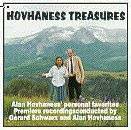
While all the other discs are from analogue sources this and CD508 are from
digital originals. Both symphonies are conducted by Schwarz who also recorded
several excellent Hovhaness discs for Delos. The 31st is in seven
separately tracked movements: I: an exercise in oriental legato; II: a
quick-witted song over string pizzicato III a minor key picture of Algerian
music with a glum pizzicato; IV a big band string fugue; V a quick allegro
vivace; VI Mahler, Grieg and (astonishingly familiar) Herrmann characterise
the andante con molto espressione and the finale is a serenade in
tranquillity. The 49th symphony takes a leaf from Sibelius's workbook.
The string writing has an eye on the Finnish master's sixth symphony. Other
voices include carols, a sense of Mid-Western wide open spaces,
Capriol (Warlock) strings. Goossens' big band would have revelled
in this.
The sleeve note assures us that the sound of the vocal works is exactly as
the composer intended. The tightly ethereal and vulnerable fallibility of
the voice of the composer's wife speaks of humanity's aspiration towards
perfect expression. The works are soulful and much beset with melisma. Vaughan
Williams' Three Vocalises (1958) for clarinet and piano are a
cross-reference as much as the high tessitura of Sibelius's Luonnotar.
O joy at dawn from the opera The Leper King is thickly accented
and ends in quivering ebon depths. I suspect that Hovhaness's operas are
extremely impressive works. Who will be the first to record The Leper
King, Etchmiadzin or Pericles.
ALAN HOVHANESS
(1911-) Celestial Fantasy (1944)
Armenian Rhapsody No. 2 (1945)
PAUL CRESTON (1906-85) Chant
of 1942 (1944) Suite for String Orchestra (1978)
NORMAN DELLO JOIO (1913-) Air for
Strings (1967) JULIUS CHAJES
(1910-) Israeli Melodies (?)
VINCENT PERSICHETTI (1915-) Introit
for Strings (1965)
 rec July
1982 Tel Aviv CRYSTAL RECORDS CD508 [58:23] rec July
1982 Tel Aviv CRYSTAL RECORDS CD508 [58:23] |
 |
Save around 22% with
Crotchet
Amazon
US |
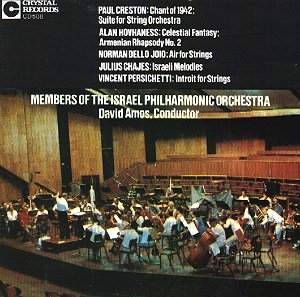
This CD is not part of the Crystal Hovhaness '800' series but nicely complements
it. HOVHANESS'S Celestial Fantasy is subdued and inward with
over-the-shoulder glances at Warlock's Capriol but with the accustomed
oriental sway and twist. The Second Armenian Rhapsody (which closes
this disc) is similar to the other two rhapsodies with its long-lined swaying
tunes, pizzicato and wilder court dances. Not consistently compelling but
well-rounded and always tuneful. The disc partners David Amos conducting
a generous Hovhaness collection (almost 70 minutes) with the Philharmonia
on CD810 and Amos conducting the Artik Concerto on CD802.
PAUL CRESTON's romantic and tuneful music has, surprisingly, made little
headway despite its obvious strengths. Several of his symphonies have made
it onto CD (and Naxos will add to that small store in 2000). No doubt there
would have been a complete symphonic cycle from Gerard Schwarz if only Delos
had not run out of stamina (and cash).
Creston's Chant of 1942 is overcast, emotional and heavy with tragedy
redolent of the deathly times in which it was written. The liner notes relate
the music to the despondency of the times and the horrors of Greece, Poland
and Lidice (compare Martinu's and Alan Bush's works referring to Lidice).
The final section of the Chant is like some muffled clock, desperate
and at the same time threatened and empyreumatic. Surely this work takes
some inspiration from Shostakovitch's Leningrad Symphony as well.
What a surprise to discover the melting lilt of Creston's Suite For
Strings (1978). The whole thing lasts less than 16 minutes and is in
four movements, by turn, jaunty-lilting; scattily carefree; hauntingly
serenading; and the final fugal Cumulus throws and spins the tunes
of the three previous movements together in a careful and concentrated display.
NORMAN DELLO JOIO's Air for Strings (1967) is a tender serenade of
crystal brevity. CHAJES Israeli Melodies are a simple and dignified
set of string songs. Nothing grates. The down-side is that there is a certain
blandness about the music which is cast off only in the opening intensity
of Song of the Night. PERSICHETTI'S Introit is not simple.
It inhabits the desolate places of Warlock's Curlew and the misty
streams of Bernard van Dieren's imagination.
The fine notes by Anne Ford-Horne are in English only as are all the Crystal
discs reviewed in this sequence.
Recommended for anyone wishing to add a tuneful collection of string works
to their collection. Committed Crestonians (and we do exist) and Hovhaness
acolytes will also need this polished and well-balanced album.
Reviewer
Rob Barnett

Should you not wish to use the purchasing links provided you can purchase
direct:
Price 16.95 US dollars plus 2 US dollars per shipping within USA. Orders
from outside the USA please contact Crystal direct for quote. Credit card
orders (Visa or MC) are accepted.
Crystal Records, 28818 NE Hancock Rd, Camas, WA 98607, phone
360-834-7022, fax 360-834-9680
email: order@crystalrecords.com
web: www.crystalrecords.com
